I believe some models have the back and front glued together. If this is the case, some elbow grease, caution and patience will be required. While I have not removed my top cover I did manage to unglue the end part and mod the clicky.
Just received it 2 days ago, and the tailcap rubber came off within a few minutes of ownership … and the only way to put it back in properly is to remove the tailcap end of the flashlight!
Well I’ve tried boiling the whole battery compartment (sealed in plastic bag of course) for almost 10 minutes, then on another occasion tried freezing it for a couple of hours, and on numerous attempts used vice grips and also strap wrenches … and NO luck!
Crelant’s obviously used more than just loctite on some of these - I’ve also read of similar reports by some CPF members.
About the Driver - I’ve read of someone drilling a couple of holes into the positive contact plate (battery side) then pulling it out with pliers or something to access the driver!! Of course you’d need to be careful not to damage the contact plate … unless you have a source for replacing it.
Good luck
Ahh, ok - that's what Wayne (vinh) must have done to mine (and others). I, just a couple of hours ago, was able to remove the contact plate (was simply pressed in), and got access to the driver. He must have drilled first, then after removing it, cut the contact plate back on 2 sides. He stripped all the components off the contact plate, backside (this is normal to use the old driver as a contact plate), and added a KD V2 driver, looks like, with 4 extra 7135 380's, so total was 4.52A -- think this is way too much, though at the time I asked for that, not knowing then what I do now.
The problem I'm having is the brightness drops significantly in the first 3 minutes it's on - ceiling bounce test shows it goes way down, from 170 to 90 lux. I suspected this was happening all along but didn't measure it until recently when I got a light meter. I thought the cause was the over-driving at 4.5A, so I reduced it to 3.8A -- but brightness still drops.
Next thing I don't like is the driver was simply suspended in air, with a ground wire going to the brass housing interior, and the driver wrapped in duct tape to prevent shorting on anything. Also, the driver looks previously used w/solder all over the edges, solder splashes, etc., so my plan is to replace the driver, add a sanded down brass pill and solder it inside the brass housing - this will give the driver a full proper mounting with a good ground and heat sink, and still use the old contact plate/driver to provide the battery + wire.
If the driver fix/mount still doesn't work, must be something to do with the LED, but still don't know how to get to it. Can't get past the lens and I don't even see anything that could be glued - the lens appears to be behind a ridge, so seems like no way to get it out from the front...
I reckon the driver is the culprit mate! Being suspended in air and wrapped in duct tape is very amateur work - not only is the driver not heatsinked, but the duct tape is trapping the heat in!! Very disappointing workmanship … and interestingly, I bought a custom XR-E pill from that same modder that also looked previously used, with messy soldering and splashes on it.
All the best with your driver upgrade / fix Tom … I’ll try the same thing with mine when I get a chance.
Cheers
[quote=d337944]
Hhhmmm, oh boy, I was trying to justify this, but I guess it sounds bad, but that's what it is... I know he knows what he's doing, maybe he was just rushed and short of parts at the time...
I'll find out soon enough if it's the driver - working on it tonight, may not be able to finish it this evening though.
Will it work with 2x18650?
Yup, it even works with 1x18650, although there is a very slight decrease in output.
Hey Tom, mind taking some pictures of the insides?
I’m having some difficulty getting the driver out… or disassemble the head in the first place.
I’m not even sure where to twist, as it seems to be epoxied pretty well. ![]()
Sure! Wife's birthday today. gotta run to get her something  , hope can post some soon. For the head, I can't get past the lens. For the driver, they drill one hole on each side, opposite each other, of the + contact board, outside the brass ring. Once you do that, you can get more leverage (screw driver in the hole, applying force to pry it up, etc.), but I'm not sure about it being soldered or epoxied - mine looks like it was maybe soldered (don't know how they could have done that, unless it was done on my modded light later??).
, hope can post some soon. For the head, I can't get past the lens. For the driver, they drill one hole on each side, opposite each other, of the + contact board, outside the brass ring. Once you do that, you can get more leverage (screw driver in the hole, applying force to pry it up, etc.), but I'm not sure about it being soldered or epoxied - mine looks like it was maybe soldered (don't know how they could have done that, unless it was done on my modded light later??).
Thanks for your reply! Take your time with the pictures, spend some time with your loved ones. ![]()
Drilling a hole in the driver board sounds slightly scary to me. ![]()
Although I’ll probably do that eventually, for now I’ll continue to pry it and try to loosen the threads on the head.
Cheers!
Good to know, thank you very much ![]()
I have another thoughts, would like to know if I’m right (know very little about this): lets say we have flashlight that works with 3 batts in parallel, 5A on HI. So, as far as I understand, if I insert 1 batt, it will work well if that batt is IMR o very good ICR, right (to provide 5A of current)? If I’ll try it with 2, it will be 2,5A per batt, right? (and 1,66A with 3). Thanks.
I have another thoughts, would like to know if I’m right (know very little about this): lets say we have flashlight that works with 3 batts in parallel, 5A on HI. So, as far as I understand, if I insert 1 batt, it will work well if that batt is IMR o very good ICR, right (to provide 5A of current)? If I’ll try it with 2, it will be 2,5A per batt, right? (and 1,66A with 3). Thanks.
I'm pretty certain that's correct. The circuit, say, is designed to draw 5A. For batteries in parallel, the voltage remains the same (up tp 4.2v), so, it draws 5A and if there's 1, 2, or 3 batts, it should just split the load. I've been testing the 7G9 with just 1 battery to verify the amps drawn from the batteries. For 5A, single battery applications, you have to have a quality battery that can produce that amount of current for a period of time. With 3 batteries, it's not so crazy of a draw per battery and you get a longer run-time of course. The 7G9 is the same as the SRK in this respect (i.e. parallel wired batteries), though you are driving 3 LED's in an SRK. In a 2 or 3 cell serial battery setup (end to end), you add the voltages of the batteries, so for 2 batts, the voltage output can be up to 8.4 volts -- most of these drivers are designed for up to 9 volts I believe.
Thanks for clarifying that ![]()
![]()
Spot on Tom E - parallel batteries share the load, so that means less stress per battery (on high amp draws) and theoretically longer battery lives. Also there is less chance of mismatched Voltage problems, and no chance (I believe) of reverse charging … meaning (all things being equal) running batteries in parallel has less chances of catastrophic failure than batteries in series!
The main drawback is the apparent lack of ready-made high output drivers for “single” battery configurations, vs the many available for “in-series” configurations.
If I have time today I’ll try to drill a couple of holes in the positive contact plate and remove it, then put up some photos and any pertinent notes … that way we’ll see how to get into a factory-standard 7G9 from a novice modder’s (including me) point of view. I’ve already ruined the anodizing trying to remove the well-epoxied tailcap, so might as well bugger up the rest of the flashlight!
Oh, happy birthday to your wife Tom E! I think you should stay away from your flashlights for today at least … keep the missus happy ; )
Oh, happy birthday to your wife Tom E! I think you should stay away from your flashlights for today at least … keep the missus happy ; )
Thanks! She read your post!!
Wife is on the phone with her mother, so got a chance to upload some pics. What d337944 is saying is right and it would be better from a stock light - mine already was modified, and since I didn't do the mod, I can only guess how it was done.
This is the + contact board, cutback as I described:
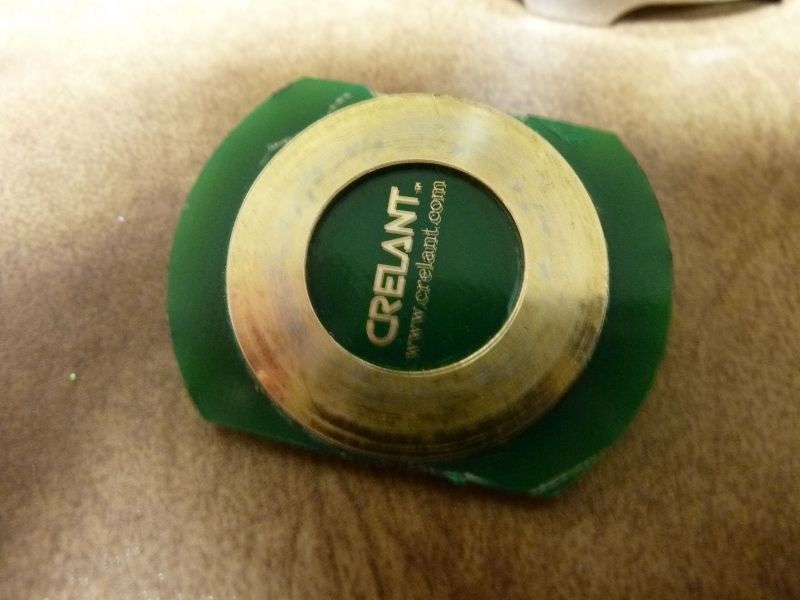
Here's the backside view with all the chips removed. Notice those 4 contact pts on the edge where it looks like it was soldered:
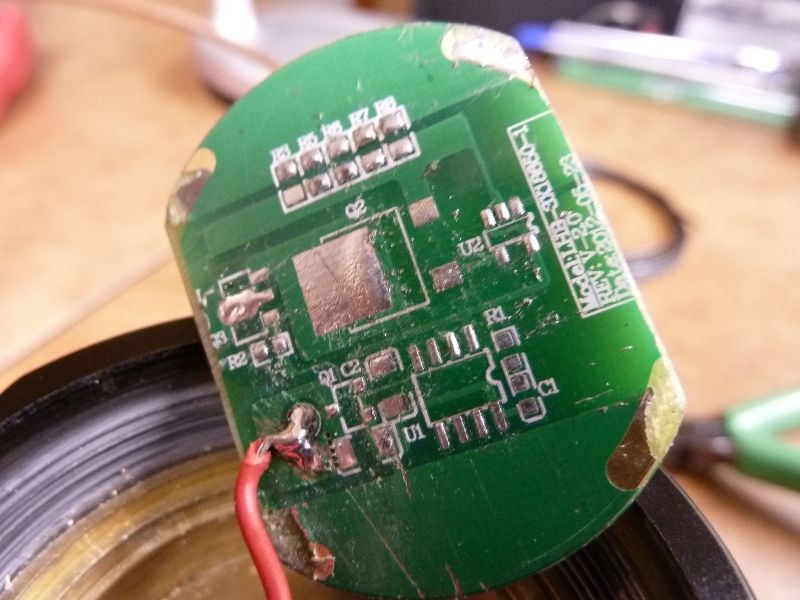
This is how it was wired up, after removing the duct tape:
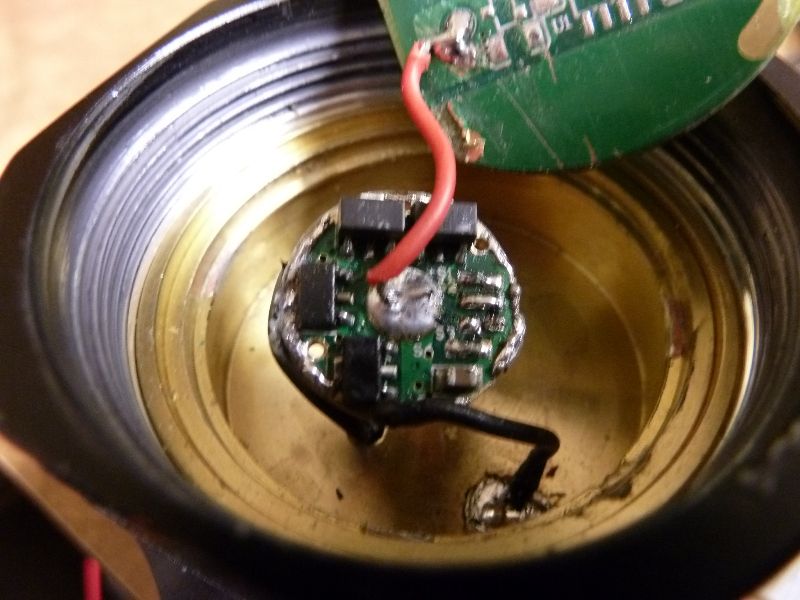
This is a view of the interior cavity. I added a brass pill, partially ground down for mounting the 17mm driver to. But you can notice the outer rim where the + contact board was soldered/glued/epoxied (don't know):
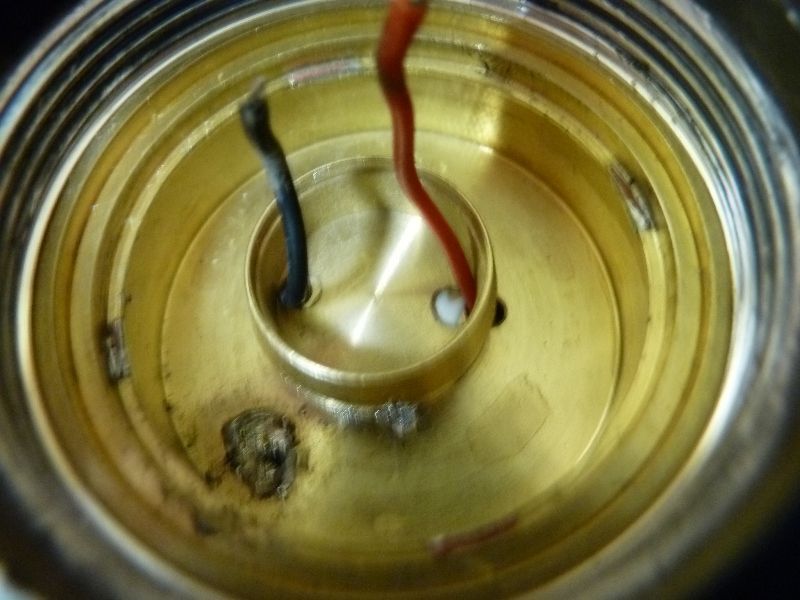
Full head view with the contact board out:
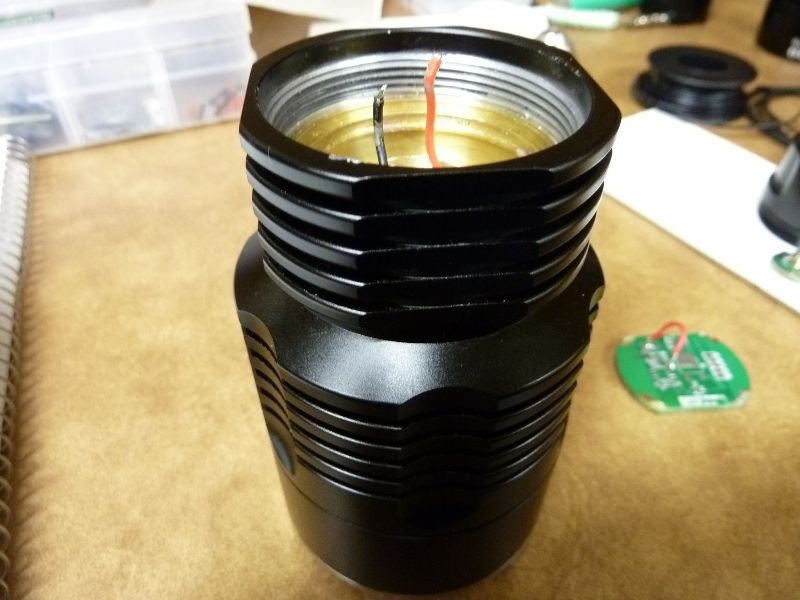
One more close-up view:
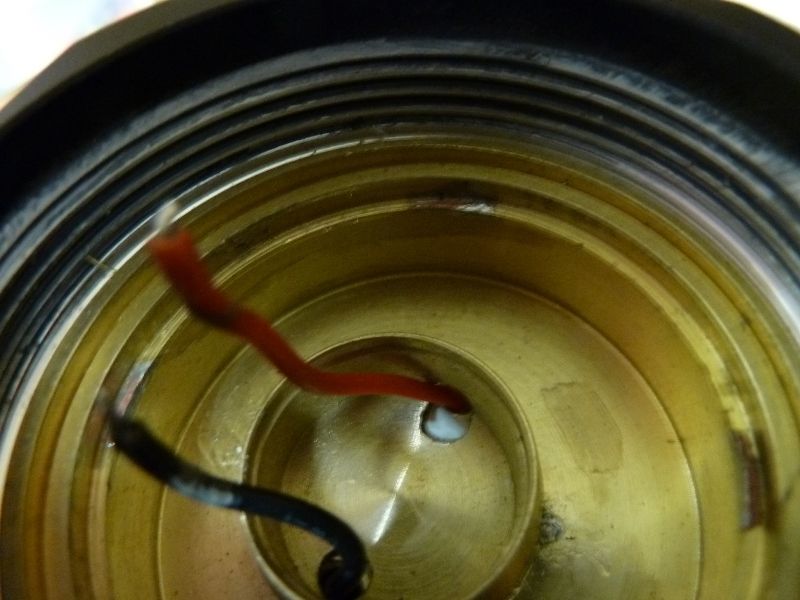
My plan is to mount the new driver, a Nanjg 2.8A plus 3 350's, total of 3.85A. Space is real tight for vertical clearance, but I measured then test fitted - seems like it will work. The + and - LED wires will be a tight squeeze in the reduced size brass pill, but I need the extras length on the wires in order to do the soldering inside the head assembly to the driver board. With the brass pill thermal epoxy'd to the brass base, then solder points added on the outside for electrical battery negative, this should give it a solid path for both thermal and electrical continuity.
Those blank brass pills have come in so handy on several light projects, I just ordered 10 more (5 for $3.50) from FancyFlashlights.com!!
Wow - thanks for your photos Tom E - shows us very well how the head is constructed! And … you didn’t get your wife another flashlight for her birthday did you? ![]()
I like what you’re planning mate, and how you’re using a brass pill for the holder.
I’ve just noticed that www.intl-outdoor.com are now stocking 4 Amp and 5 Amp drivers suitable for our needs … but I’m not sure whether they can fit into your brass pill.
I’ll open mine up when I get some time … and I reckon I’ll give the intl-outdoor drivers a try.
Keep us updated mate, and I’ll do the same when I can. ![]()
No, no flashlights for her, but there is one handy on just about every table or stand in the house! Well, she's not too happy bout that though...
I think Match's tests show going over 4 amps for a single XML won't help much though. Possibly the lumens curve vs. amps would look better on those new XM-L2's. I got a couple of XML2 T6's, but would love to put a XML2 U2 in the 7G9 - didn't order any yet, but planning to, probably from IlluminationSupply.com - he's got them. I can't see anyway of getting at the LED from the front - seems like the lens is impassable and though there is an embedded groove or ring little further down from the bezel, I can't see any joint in there - looked with a 10X glass. It's possible from the backend, that big brass piece unscrews if you can use a tool that applies pressure to the outside (reverse wrench?), maybe you can get enough bite on the brass and see if it will unscrew from the aluminum. Someone out there knows.....
You’re right about the max Amps there Tom - I reckon I’ll get the 4 Amp driver to be safe.
Also, we don’t really know how much current the standard switch will safely handle … 4 Amps “should” be okay I hope … safer than 5 Amps at least!
Cheers for now mate!
Thanks for the photos Tom!
Now if I just figure out how to get sucker open……
You reckon direct-drive would be too much for the LED? ![]()
Edit: Does anyone else have loose o-ring? When I twist the body to assemble the light, the o-ring becomes stretched and it gets caught…
Every annoying in my opinion, as it almost always happens when I replace batteries.

Hi Ryansoh
Direct Drive may work, but could also destroy the LED … it would be safer to use a small ohm resistor just to cut down the current a little. However the switch is also an unknown, as it may give too much resistance to make the Direct Drive worth while … or may even burn out / melt quickly!
Its a great flashlight though, and bumping up the Amps could turn this into a fantastic thrower!
Cheers